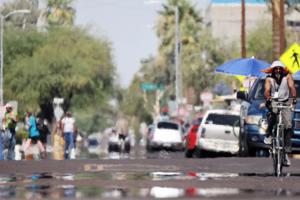Entertainment
/ArcaMax

7 tips for avoiding food poisoning while traveling
Why do we travel? Novelist Gustave Flaubert famously said, "Travel makes one modest. You see what a tiny place you occupy in the world." Travel journalist Bill Bryson once remarked on his love for the childlike wonder that comes with being in a new country. And Hans Christian Andersen, author of "The Little Mermaid," simply said, "To travel is ...Read more

5 tips for protecting your phone while traveling abroad
Picture this: You're on vacation in a city abroad, exploring museums, tasting the local cuisine, and people-watching at cafés. Everything is going perfectly until you get a series of alerts on your phone. Someone is making fraudulent charges using your credit card, sending you into a panic. How could this have happened?
Cyberattacks ...Read more

Competition in the AI sector is heating up. Here's how it's impacting business and academia.
For decades, the field of artificial intelligence seemed stagnant. Researchers started gaining momentum in the early 2010s as deep learning proved useful in real-world applications such as speech recognition. The real inflection point, however, did not come until November 2022, when OpenAI launched ChatGPT.
The chatbot represented a huge ...Read more

Housing and food are health care: How new Medicaid rules in 8 states stand to help the most vulnerable
Americans' health care experiences are as varied as their backgrounds. For some, their income, housing, transportation, and other factors that shape their everyday lives can be obstacles to accessing much-needed health care.
However, recent changes to federal health care policies could eliminate some of these barriers. The federal agency ...Read more

Is the solution to the truck parking shortage as simple as an app?
With trucks carrying more than 70% of America's freight by weight, they're an essential part of the nation's transportation of goods. The long-haul drivers behind the wheel, who are responsible for getting those goods from point A to point B, are also essential. They often have grueling routes that require them to sleep in their cabs while ...Read more

How health care quality varies by state
After a period of health care improvements within the United States, the COVID-19 pandemic dramatically slowed its progress. The pandemic worsened patient safety outcomes and exacerbated inequities in the U.S. health system while deprioritizing other major health initiatives, according to a 2024 report by the Centers for Medicare & Medicaid ...Read more

How many workers can AI really replace? Estimates are all over the place.
Wasn't artificial intelligence supposed to take over your job by now? A year of fear and generative AI adoption in workplaces has yet to culminate in widespread job displacement—though it's too early to close the book on its potential to take over, according to some expert forecasts.
Verbit analyzed jobs data from Challenger, Gray & ...Read more

Signature sandwich from each state
The culinary landscape of the United States is as diverse as its population, with each state proudly boasting its own signature sandwich that often tells a rich story of culture, history, migration, and tradition.
From the lobster rolls of Maine to the po'boys of Mississippi, these sandwiches have become iconic representations of their ...Read more

The 411 on area codes: How new tech and population growth fuels the need for more digits
212. 213. 312. If you know, you know.
Over nearly 80 years, area codes have come to signify regional identities and a deep connection to a place. So what happens when tech and population growth collide, and the three-digit number synonymous with home is no longer available?
Spokeo analyzed the proliferation of area codes and how they are ...Read more

Influencers are upending advertising. Here are 4 ways their brand collabs have changed the marketing game.
Successful brands have long recognized the importance of giving ad campaigns a face. Though seemingly new, the trend to use influential figures in marketing stems from a storied past of using fictional characters (think Ronald McDonald or "Mikey" for Life Cereal) and celebrities in high-profile campaigns.
But with the rise of social media, ...Read more

Data shows severe depression is most prevalent among teens
Rates of depression and other severe mental health conditions have become increasingly prevalent among teens—and a modern confluence of factors may be heightening mental health challenges in young people.
The numbers are sobering: In 2021, 4 in 10 students felt persistently sad or hopeless, while 1 in 5 seriously considered attempting ...Read more

5 health benefits of honey you may not know
Used medicinally since ancient times, honey soothes coughs and comforts colds. It's perfect in a cup of tea and may even reduce symptoms from upper respiratory tract infections, according to a review of 14 studies that took nearly 1,800 people into account published by BMJ Evidence-Based Medicine journal in 2020.
Many of us may already be ...Read more

The one-hit wonders every rock music fan will remember
The term "one-hit wonder" is often perceived negatively—like the act was a flash in the pan or reaped the benefits of a popular fad or a film or television sync—but most musicians would give anything to have just one hit.
Stacker dug through the annals of rock music history and highlighted 20 one-hit wonders, identified by rock artists ...Read more

Americans' confidence in their ability to retire remains shaken
Americans' attitudes about life after work have shifted some in the last two years as higher costs of living force them to reconsider retirement plans despite stable incomes and a healthy stock market.
Wealth Enhancement analyzed Employee Benefits Research Institute data to illustrate how American confidence in retirement has changed amid ...Read more

The 5 most popular international summer travel destinations in 2024
Summer is the most popular time of year for Americans to travel, and despite concerns about inflation, 2024 could be a bustling year for summer vacations. A Nerdwallet travel report showed that more than 2 in 5 (45%) Americans plan to take a summer trip that involves booking a flight or hotel.
Family is a big component of summer plans. Four ...Read more

Developments in oncology over the last year showing promise for cancer patients and others
Leaps forward in tech and science this past year promise greater accessibility and quality of care for Americans suffering from nearly all forms of cancer.
Medical Technology Schools analyzed academic studies and resources from leading cancer research institutions, including the Mayo Clinic and the Cancer Research Institute, to round up the ...Read more

Flags for mental health: How to spot signs of a struggling child
Is a struggling child just "going through a phase," or is there something more serious going on?
Many families grapple with this question when trying to identify underlying mental health issues their child may be facing. Still, it is a complicated question. Throughout the stages of development—from toddlerhood to the preteen years and ...Read more

As temperatures rise across the US, here's how to protect yourself this summer
It's only halfway through, and already, 2024 is on its way to being one of the warmest years on record.
May marked the 12th straight month of record-high temperatures, according to the National Centers for Environmental Information. The average global surface temperature was 60.7 degrees Fahrenheit, about 2.1 degrees above the 20th-century ...Read more

How designers can make websites more accessible for the millions affected by color blindness
As people spend more time online, inclusive design has become more important than ever, as it ensures everyone can access information. Yet, according to WebAIM, a nonprofit at the Institute for Disability Research, Policy & Practice at Utah State University, as much as 95.9% of home pages are inaccessible to those with disabilities. Imagine ...Read more

The troubling link between rising rents and lower life spans: Where are renters most at risk?
A notice about increasing rent from a landlord has always come with a degree of heartburn. Now, researchers suggest it's linked to a higher likelihood of early death.
Foothold Technology analyzed a recent study by Princeton's Eviction Lab and data from the National Low Income Housing Coalition and the Bureau of Labor Statistics to illustrate...Read more





